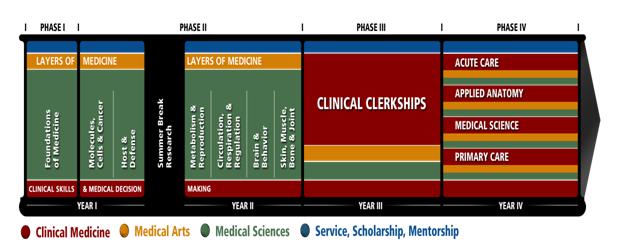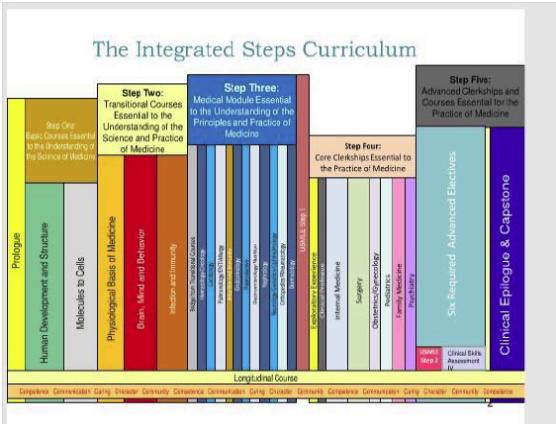Enews270 醫學院課程改革與課程整合之探討~ 醫學系課程整合的原則 Part 3
出自KMU e-News
高雄醫學大學e快報 第270期 分享園地
醫學院課程改革與課程整合之探討~ 醫學系課程整合的原則 Part 3
醫學院 劉克明教授
表六 Curriculum of University of Utah School of Medicine:
範例 II. Northeastern Ohio University College of Medicine (NEOUCOM) –
整合的階段課程 (Integrated Steps Curriculum):
- 特色:
- 醫學系全部課程包括入門導引 (Prologue)、階段1-5 (Step1, Step 2, Step 3, Step 4, Step 5),以及縱貫課程 (Longitudinal course) (如表七)。
- 醫學系一年級與二年級課程包括入門導引與前三個階段 (Prologue、Step1、Step 2、Step 3)。醫學系三年級與四年級分别爲第四個階段 (Step 4) 與第五個階段 (Step 5)。縱貫課程是成醫課程 (On Doctoring),縱貫於全部四個學年課程。
- 每一個階段逐漸地變成更聚焦於臨床醫學。
- 第一階段與第二階段主要是由基礎醫學教師授課,第三階段是採學組模式 (Block),一個學組為期 2-3 週,由臨床教師當課程協調者,而基礎醫學教師協助授課。
- 每一個學組包含傳統的演講與主動學習部分 (例如小組活動、個案為基礎的學習)。
- 第一階段 (Step 1):瞭解醫學科學必要的基礎課程。
- Human Development and Structure. 13週。
- Molecules to Cells. 7週。
- Longitudinal Doctoring – is continuous through both academic years and includes a community preceptorship with a primary care physician.
- 第二階段 (Step 2):瞭解科學及執行醫療必要的過渡期的課程。
- Physiological Basis of Medicine. 7週。
- Brain, Mind and Behavior: 8週。
- Infection and Immunity: 7週。
- Bridge from Transitional Courses: 1週。
- 第三階段 (Step 3):瞭解執行醫療與其原則必要的醫學模組課程。每一模組爲期 2-3週。
- Hematology/Oncology.
- Cardiology.
- Pulmonology/ENT/Allergy.
- Infection and Immunity.
- Endocrinology.
- Reproductive.
- Gastroenterology/Nutrition.
- Nephrology.
- Neurology/Geriatrics/Ophthalmology.
- Orthopedics/Rheumatology.
- Dermatology (End of 2nd. Year)
- Preparation of USMLE Step 1 examination.
- Exploratory Experience: 2週。
- Principles of Medicine Bridge course (Clinical Prologue): 1週。
- 第四階段 (Step 4):醫學系三年級。執行醫療必要的核心實習醫學生訓練。
- Internal Medicine: 9週。
- Surgery: 9週。
- OBS/GYN: 6週。
- Pediatric Medicine: 6週。
- Family Medicine: 6週。
- Psychiatric Medicine: 6週。
- Longitudinal Course.(End of the third academic year)
- 第五階段 (Step 5):醫學系四年級。執行醫療必要的階實習醫學生訓練與課程。
- Six Required Advanced Electives:
- Clinical Skills Assessment.
- Clinical Epilogue and Capstone: 包括 Practice of Medicine and Longitudinal Course。共包含四個構成: Clinical Competency Information, Clinical Skills Development, Senior Class Service, and Critical Reflection。
- Longitudinal Course: 縱貫課程是教授 clinical skills, professionalism, communication, and ethics, etc.縱貫課程包括五個整合的主題: Physician Identity, Patient Care, Professionalism, Population Health, and Health。
表七 Northeastern Ohio University College of Medicine (NEOUCOM) – 整合的階段課程:
3.廣濶的哲學為基礎的整合課程 (Broad-Based Philosophy-Integrated throughout the Curriculum):教學單元的構造以引導哲學 (guiding philosophy) 為基礎。
範例 I. The Johns Hopkins University School of Medicine – 從基因到社會課程(“Genes to Society”Curriculum).
- 特色:
- 課程之目標在更廣濶地重新建構健康與疾病的關係,意圖鼓勵學生在一個更大整合的課程,包括社會的、文化的、精神的、及環境的變數,去探討病人健康的生物特性。
- 此教學模式顯示病人的表現型狀 (patient’s phenotype) 是内部的 (基因、分子、細胞、與器官) 和外部的 (環境、家庭、及社會) 因素的共同決定。
- 横跨四個學年的縱貫課程與各個學習單元,皆以生物學的原則與環境的特性 (environmental individuality) 開始,而以社會對健康與疾病之間的連續之影響做結束。
- 横向課程分爲與生物醫學主題有關 (Biomedical strands),以及與社會與行爲的主題有關 (Social and Behavioral Strands)。分别如下:
- Biomedical Strands:Anatomy, Embryology, Genomics/Proteomics, Imaging, Informatics, Neoplasia , Pathology , Pharmacology, Therapeutics。
- Social and Behavioral Strands:Communication, Cultural Competence, Epidemiology, Ethics & Professionalism, Health Disparities, Health Policy, Life Cycle: Aging, Life Cycle: Growth & Development, Nutrition, Pain, Patient Safety。
- 課程强調公共衛生。
- 銜接課程 (表八黄色部分) 包含有趣的特别主題,例如疾病預防、全身的健康、疼痛等。


